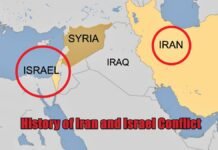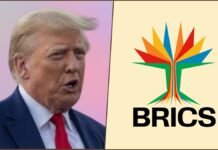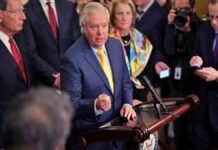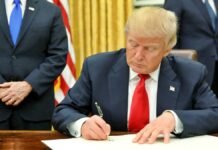
Key Highlights:
- Renaming Initiative: In a controversial executive order, U.S. President Donald Trump has renamed the Gulf of Mexico to the Gulf of America, along with changes to other historic place names.
- Google Maps Updates: Google has promptly implemented the change for American users, while retaining both names Gulf of America and Gulf of Mexico for the rest of the world.
- Mount Denali Renamed: Trump also restored the name of Mount Denali to Mount McKinley, reversing the Obama-era decision made in 2015.
- Geographical Name Policy: The U.S. Interior Ministry confirmed that changes under the Geographical Name System are officially underway.
- Google’s Global Strategy: This renaming aligns with Google’s longstanding policy of adopting officially recognized names, tailored to regional contexts.
Washington, D.C.: As part of his first week in office after being sworn in for a second term on January 20, U.S. President Donald Trump has wasted no time in implementing his vision for America. In a bold and polarizing move, Trump issued an executive order instructing the renaming of several historic places, including the Gulf of Mexico, which will now be known as the Gulf of America.
As expected, this decision has stirred widespread debate, with reactions ranging from support among Trump’s base to criticism from historians, environmentalists, and international allies.
Gulf of Mexico Becomes Gulf of America: Google Maps Responds
In response to Trump’s order, Google Maps updated its U.S. platform to reflect the new name. Users in the United States will now see the Gulf of America label prominently displayed, while users from other countries will see both names, Gulf of America and Gulf of Mexico, displayed together.
In a statement shared on Xpost, Google Maps explained its approach:
“It has been our long-standing policy to implement officially recognized name changes as soon as they are announced by credible sources. For now, this name change will apply only to American users.”
This localized implementation underscores Google’s regional strategy for maintaining accuracy while addressing varying international perspectives on geographical terminology.
Other Renaming Decisions: Mount Denali to Mount McKinley
As part of Trump’s renaming initiative, another significant change involves Mount Denali, the highest mountain in North America. The mountain, renamed by the Obama administration in 2015 to honor its Native Alaskan heritage, will revert to its previous name, Mount McKinley, after the 25th U.S. President, William McKinley.
The U.S. Interior Ministry confirmed these renaming efforts are in compliance with the Geographical Name System and stated:
“These changes are officially implemented, and full updates will be completed soon.”
Trump’s decision to restore historical names has drawn praise from his supporters, who view it as a move to emphasize American heritage, but has also reignited debates about respecting Native American history.
Controversy Surrounding Renaming Decisions
National Reactions:
- Supporters of Trump argue that the renaming reinforces national pride and aligns with his “America First” agenda.
- Critics, however, view such moves as unnecessary political gestures that undermine historical and cultural inclusivity.
International Implications:
The renaming of the Gulf of Mexico to Gulf of America has sparked international debate, particularly as the Gulf touches the shores of Mexico, a neighboring country. Mexican officials have not yet publicly responded to the change, but experts believe this could strain diplomatic relations further.
Google’s Naming Policy: A History of Controversies
This is not the first time Google Maps has faced challenges over geographical naming. The company has previously had to navigate politically sensitive issues, such as:
- Sea of Japan vs. East Sea: Google lists both names to address disputes between Japan and South Korea over the same body of water.
- Persian Gulf: In 2012, Iran threatened legal action after Google removed the term “Persian Gulf” from its maps, leaving the area between Iran and the Arabian Peninsula unnamed. It was later restored as the “Persian Gulf.”
Google’s dynamic policy on geographical names seeks to balance international relations while adhering to official government announcements in each country.
What’s Next: Impact of Trump’s Geographical Rebranding Efforts
The renaming of places like the Gulf of Mexico and Mount Denali illustrates Trump’s commitment to his “America First” narrative, with symbolic changes designed to resonate with his domestic base. However, these decisions also raise questions about:
- U.S.-Mexico Relations: Will renaming the Gulf of Mexico sour diplomatic ties with Mexico, especially amid ongoing trade and border discussions?
- Cultural Sensitivity: Restoring Mount McKinley diminishes recognition of Native Alaskan heritage associated with the name Denali. Could this spur domestic backlash from indigenous communities?
- Historical Context: Critics argue that altering established geographical names erases history and creates unnecessary complications, both for citizens and global users.
A Polarizing Start to Trump’s Second Term
President Donald Trump’s decision to rename the Gulf of Mexico as the Gulf of America and revert Mount Denali to Mount McKinley marks a dramatic start to his second term. While these changes symbolize his emphasis on patriotism and heritage, they also highlight the challenges of balancing historical reverence, cultural inclusivity, and diplomatic relations.
With Google Maps updating its U.S. platform to reflect these changes, the story of Trump’s geographical renaming efforts is far from over, as it continues to provoke debate both domestically and globally. As critics and supporters weigh in, the lasting impact of these decisions will unfold in the months ahead.

















































